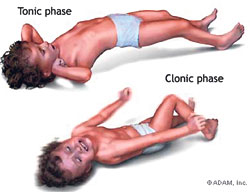FEBRILE SEIZURE:? Parents, DON’T panic
| ||||
| By Kumudini Hettiarachchi, Pic by M.A. Pushpa Kumara | ||||
| Your baby or toddler is having a fever. Suddenly his whole body begins to shake and jerk, going into convulsions, his eyes roll back and he loses consciousness. Panic-stricken, your reaction, quite naturally, would be to hold the child under the shower or do vigorous sponging, because you have heard that you must bring the fever down to stop the convulsions. The next would be to rush the child to the nearest doctor or hospital.
"Don't panic, be calm," she urges, "because it is very important to observe the child during a febrile seizure so that you can tell the doctor how long the seizure lasted, whether the whole body or only one side was affected, whether it was one or many episodes and other vital information for a treatment plan thereafter." Reassuring parents that a majority of children who suffer febrile seizures are not in danger as most assume, Dr. Wanigasinghe explains that a fever indicates that the child's body is fighting some kind of infection. Sometimes such a fever within the body may release mediators which alter neuron excitability or in simple terms a fever may affect the functioning of nerve cells in the brain, causing seizures in the body. The degree of the temperature is not an indicator that a child may suffer a febrile seizure, says this Consultant Neurologist. Some parents report that at the time their child developed a seizure, there was no sign of an underlying febrile illness, she says, dispelling the misconception that very high fevers would bring on such seizures. Children in the age group six months to five years old are vulnerable to febrile seizures, MediScene understands, with more boys than girls being prone to such fits. The prevalence is about 2-5% of all children in that age group. There should, however, be a genetic predisposition (25% have a family history) to develop a seizure, during a window period in your brain development (maturation). Febrile seizures can be categorized into two, according to Dr. Wanigasinghe: Simple febrile seizures - These last less than 15 minutes, with convulsions coming on within the first 24 hours of a child getting a fever. From among those who suffer febrile seizures, 75% are prone to these. Even among these children, 80-85% suffer only a seizure which lasts less than five minutes. Complex febrile seizures - These are prolonged seizures which last more than 15 minutes, many seizures which occur one after the other (multiple episodes) during the same febrile illness; occur after the first 24 hours; or affect only one side of the body. (See box on how to handle febrile seizures at home)
The symptoms
What you should do
The concerns of parents are many. Here Dr. Wanigasinghe deals with some of them. Is there a risk of death when a child suffers a febrile seizure? Reports have not indicated any deaths due to febrile seizures. Is there a danger of recurrence of fever-induced febrile seizures? Yes, febrile seizures recur in three out of 10 children, with factors such as having the first seizure at a young age of less than 18 months, and having family members with a history of febrile seizures increasing the risk. If the seizure occurs soon after a fever has begun or when the temperature is relatively low, the risk of recurrence is higher. Will such seizures lead to a child having a low IQ? There is population-based evidence that there is no difference in the IQ of children who have suffered febrile seizures and those who have not. Will the child develop apasmaraya or meemesmore (epilepsy)? A seven-year-old child, who has had simple febrile seizures, has the same risk as one of the same age who has not had such seizures, with regard to developing epilepsy. At 24 years of age, however, the risk may be a bit higher, 2.4%, if the very first seizure occurred within the first year of his life and there is a family history of epilepsy. Severe multiple episodes as in the case of complex seizures, seizures which affect only a part of the body, and children with cerebral palsy, delayed development or other neurological abnormalities would also be more at risk of developing epilepsy. Full article here |
Information, News & Discussion about Infant Pediatric & Adolescent Neurology & Sleep Disorders. Science Diagnostics Symptoms Treatment. Topics include: Seizures Epilepsy Spasticity Developmental Disorders Cerebral Palsy Headaches Tics Concussion Brain Injury Neurobehavioral Disorders ADHD Autism Serving Texas Children's Neurology, Epilepsy, Developmental & Sleep Problems in The Houston Area and The San Antonio / Central & South Texas Areas
Sunday, June 17, 2012
FEBRILE SEIZURE:? DON’T Panic
Subscribe to:
Post Comments (Atom)


No comments:
Post a Comment